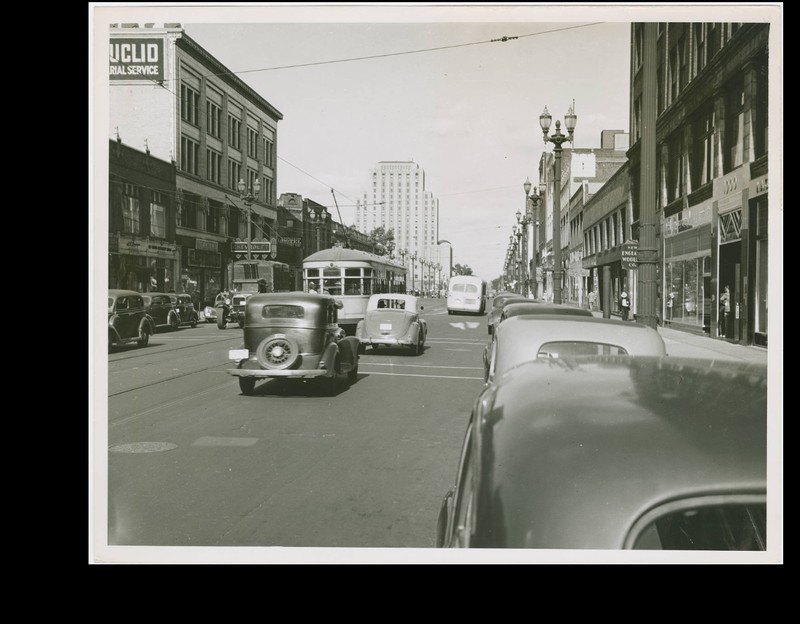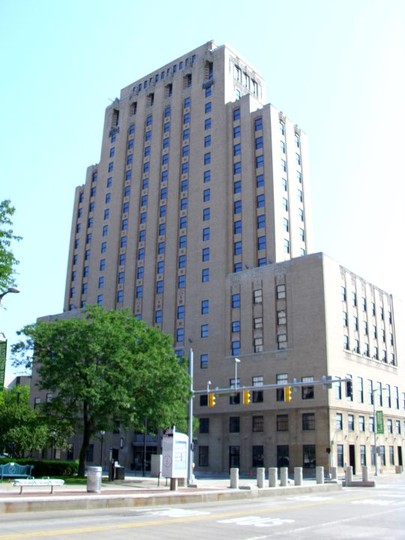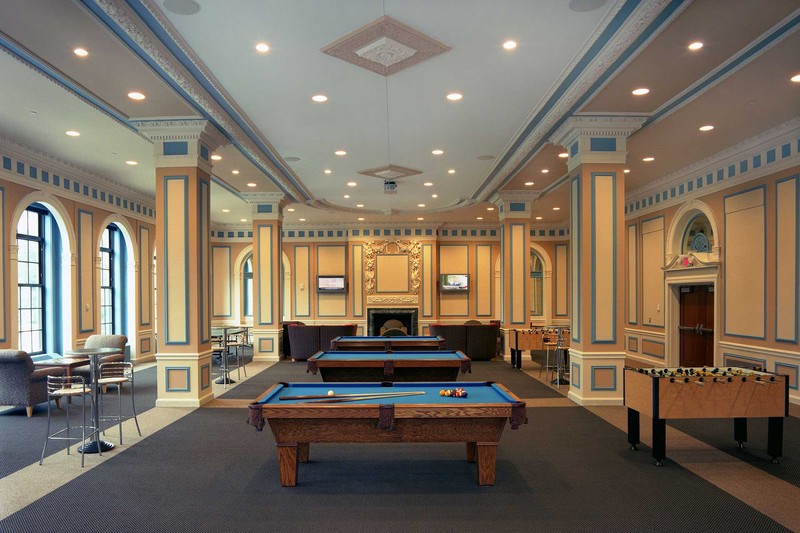Fenn Tower (National Town and Country Club)
Introduction
Text-to-speech Audio
Images
Fenn College during the late 1930s or early 1940s. The tower is visible in the background.

2015 photo of Fenn Tower of Cleveland State University

Student lounge at Cleveland State's Fenn Tower. The tower was recently renovated by OCP Contractors, who took the photo.

Backstory and Context
Text-to-speech Audio
Few buildings speak to the dichotomy of the 1920s versus the 1930s than Fenn Tower, originally known as the National Town and Country Club. Construction started in 1929, a mere couple of weeks before the infamous stock market crash, on what would become Cleveland's third tallest building at the time, and its purpose was nothing more than to house a businessmen's club. However, by the time it opened in 1930, the Great Depression was underway. The members met for a Christmas lunch in the building, but they never used it again. In 1937, Fenn College purchased the 22-story skyscraper and renamed it Fenn Tower in 1939. Fenn, a private college and predecessor of Cleveland State University. The college used it for its offices, additional classrooms, a library, gym, pool, students and faculty lounges, and numerous other amenities, eventually gaining the nickname "the campus in the clouds." Nonetheless, the building's existence exists because of the optimism and wealth accrued by entrepreneurs during the 1920s, while its history as a building that functioned as everything but a business club demonstrates the misguided nature of their expectations.
The National Town and Country Club hired New York architects George Post & Sons to build its enormous club. Private clubs for business people grew wildly popular during the late nineteenth and early twentieth centuries (and it made it possible to enjoy drinks during Prohibition). The club's board sent a letter to its 1,400 members before the project began proclaiming that the time was ripe for creating such a luxurious club. When finished, the skyscraper stood 22 stories high -- the city's third tallest building at the time -- and featured a gym, pool, dining room, and 120 bedrooms used by the club's members. It was a celebration of financial success and opulence in planning, but by the time it opened, the Great Depression had set-in, and a new reality emerged.
For seven years after that one-and-only event, the building remained vacant. With Cleveland's 30% unemployment rate, one can only imagine how people viewed the building during the 1930s, whether they had enjoyed riches during the 1920s or not; a towering reminder of an economy gone awry. Still, the building's history did not stop with the Great Depression. Fenn College (the predecessor to Cleveland State) purchased the building in 1937. The college converted the men's dining room into a wood-lined library, turned the billiard room into a student lounge, and used the swimming pool for its athletic competitions. Moreover, besides enjoying a tremendous size, each dorm room included a private bathroom (an unimaginable luxury even by today's standards).
The college's history also enjoys roots back to the beginnings of the Gilded Age, but the narrative differs from the story attached to the businessmen who built the skyscraper. Fenn College arose out of the YMCA's educational program that began during the 1880s. The organization first started with an evening school intended to aid workers and immigrants seeking to better their prospects. By 1906, the group added a day school to its evening programs. In 1921, the YMCA's educational arm transitioned into the Cleveland School of Technology, offering college courses in engineering and business by 1923 and conferred its first degrees in 1927. Three years later, the program again changed names, becoming Fenn College -- a name that would stick for decades. Fenn served as Ohio's second college to adopt a cooperative education program that allowed students to alternate classroom work with employment; they financed their education while obtaining practical work experience.
The Fenn College program proved successful; the college never operated at a deficit. However, by 1963 financial constraints pushed the college to pitch a formal plan to the state to develop a state university in Cleveland, utilizing Fenn College as its core. On December 18, 1964, Governor Rhodes signed legislation creating Cleveland State University. The skyscraper mainly evolved the residential section of what became a multi-campus university.
Its location on the famed Euclid Ave is near the former site of two of Millionaire's Row mansions: Rufus K. Winslow, a Great Lakes shipping magnate, and G.E. Herrick, a businessman and largest stockholder of the Cleveland Railway Company, a stark reminder that the skyscraper arose initially to serve wealthy entrepreneurs looking to bask in the glory of their wealth, but the Great Depression altered the building's function into one that mainly tied to academics and educating those who primarily worked as employees, not employers. Yet, the tower's intention to serve as a lap of luxury remains a big part of its story. Indeed, even Cleveland State's description of Fenn Tower speaks to its draw as a posh residence: "Fenn Tower provides the privacy and lifestyle you deserve...only at Fenn Tower will you find the privacy, freedom and academic environment you are seeking, coupled with the lifestyle of a luxurious student community."
Sources
Theiss, Evelyn . "Fenn Tower's opulent start as social club quickly faded in Depression era: Elegant Cleveland." The Plain Dealer (Cleveland) January 12, 2019. Arts sec. https://www.cleveland.com/arts/2012/05/fenn_towers_opulent_start_as_s.html.
Encyclopedia of Cleveland History. "Fenn College" Case Western Reserve University. case.edu. Accessed October 14, 2020. https://case.edu/ech/articles/f/fenn-college
"Fenn Tower," Cleveland Historical, accessed October 14, 2020, https://clevelandhistorical.org/index.php/items/show/54.
https://ohiomemory.org/digital/collection/p267401coll34/id/5015/
By Tallonator at English Wikipedia, CC BY 3.0, https://commons.wikimedia.org/w/index.php?curid=48265992
https://ocpcoc.com/projects/csu-fenn-tower
